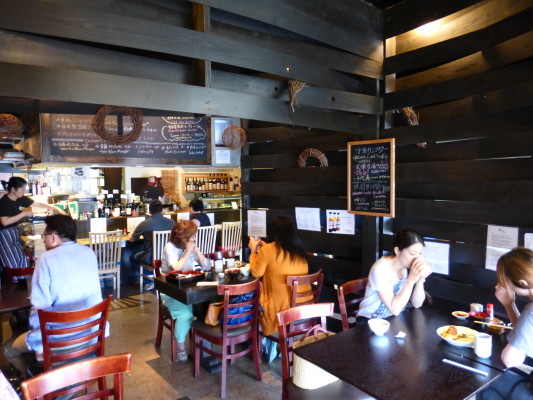Ojiya brings Japanese regional cuisine to Torrance mini-mall [RESTAURANT REVIEW]

Ojiya, a small eatery tucked away in a strip mall in Torrance that offers rare, traditional fare from the mountainous north of Japan. Photo .
The variety of regional Japanese cuisine is astonishing given the size of that country; the nation’s land area is slightly less than that of California. On the other hand, the terrain of mountainous islands helps create isolated populations that develop their own traditions, and the variety of ecologies from snowbound to tropical means there are plenty of unique ingredients in each zone.
There are little restaurants all over LA that celebrate these traditions, one of which is Ojiya, a little strip mall eatery with a nondescript exterior. Inside it’s much more interesting, a cozy setting reminiscent of a farmhouse in Niigata, northern Japan. The already small dining room is subdivided with wooden slats, creating intimate private spaces.
We wanted to try some of the unique regional izakaya items, and our server was happy to oblige with suggestions. We ordered a variety of small plates and asked him to bring them out in whichever order was appropriate. First was battera, the most ancient type of sushi, in which marinated mackerel is pressed with leaves and aged before serving. If you think of the goal of sushi is to use the freshest seafood, that sentence might seem strange, but this started as a way to preserve fish, a form of pickling. The vinegared fish has a dense texture and slight tart sourness, and it’s a must-try for those who want a flavor of antiquity.
Almost immediately afterward, soup arrived – a crab, mushroom, and rice porridge with rich, warm flavors that complemented the battera. Ojiya makes their own dashi, the fish and seaweed stock that most restaurants buy, and the difference is obvious; the stock had a rich, almost buttery flavor instead of the harsher and saltier taste of commercially processed brands.
Our fried items came next – Niigata-style pork cutlets and housemade fish balls. Most fish balls are ground to a very fine texture, but this was coarsely chopped before being breaded and fried. Both texture and flavor were more interesting than usual, and these are my new standard for excellence. The pork cutlet hit the spot too – it had been marinated in a sweet sauce before breading, a technique our server said was particular to northern Japan. The crisp cutlets were served with a cabbage salad along with housemade onion-miso dressing, and this was sufficiently good that I wasn’t surprised to see that they sell it by the bottle.
Ojiya offers sake and flavored shochu samplers – three small glasses for only eight dollars in the latter case. I tried the apple, grapefruit, and shiso mint infused shochus, and would happily have the shiso and citrus versions again, but found the apple overly sweet. The sake sampler was twelve dollars and showed off three different styles, from a mild version that resembles a pinot grigio to a richly flavored variant with grassy overtones.
Our dinner for two with drinks was only $56, very modest for a full Japanese meal, and I returned for lunch a few days later. I had wanted to try another house specialty, the buckwheat soba. This is offered with grated yam or tempura, and though the yam sounded interesting I decided to see if everything coming out of that fryer was as good as the fish balls.
My entrée was preceded by a small salad with more of that tasty house dressing, a small block of firm tofu topped with spicy minced ginger and scallions, and sweet rice wrapped in fried tofu skin – quite a variety for a modestly priced lunch. Then came the main dish: cold noodles topped with shredded seaweed, served with chopped scallion, wasabi, and a dipping sauce, with the tempura on the side. I wasn’t sure what to do with this so asked my server – he said I should mix the scallion, wasabi, and sauce to my liking, then dip the noodles. These are usually made from buckwheat flour, but in Niigata a small amount of seaweed is used in the noodle dough. They had a firm texture and a simple and pleasant flavor by themselves, but were very good when alternated with bites of the crunchy tempura. Cold soba is a traditional hot weather meal in Japan, and I see why – it was very refreshing.
I came to my meal not knowing much about the culinary traditions of Northern Japan, as I suspect would be the case for somewhere above ninety percent of the people who read this. The servers were helpful and patient on both occasions, so I now know a little more. I’m ready to keep studying, as long as the lessons remain this tasty.
Ojiya is at 21008 Hawthorne Boulevard in Torrance. Open for lunch Tue-Fri 11:30 AM-2PM, dinner Sun and Tue-Thu 5:30 PM-10 PM, Fr-Sa 5:30 PM-11 PM. Parking lot, alcohol served, children welcome, wheelchair access good, some vegan items. Menu at ojiyausa.com , phone 310-793-7000.

